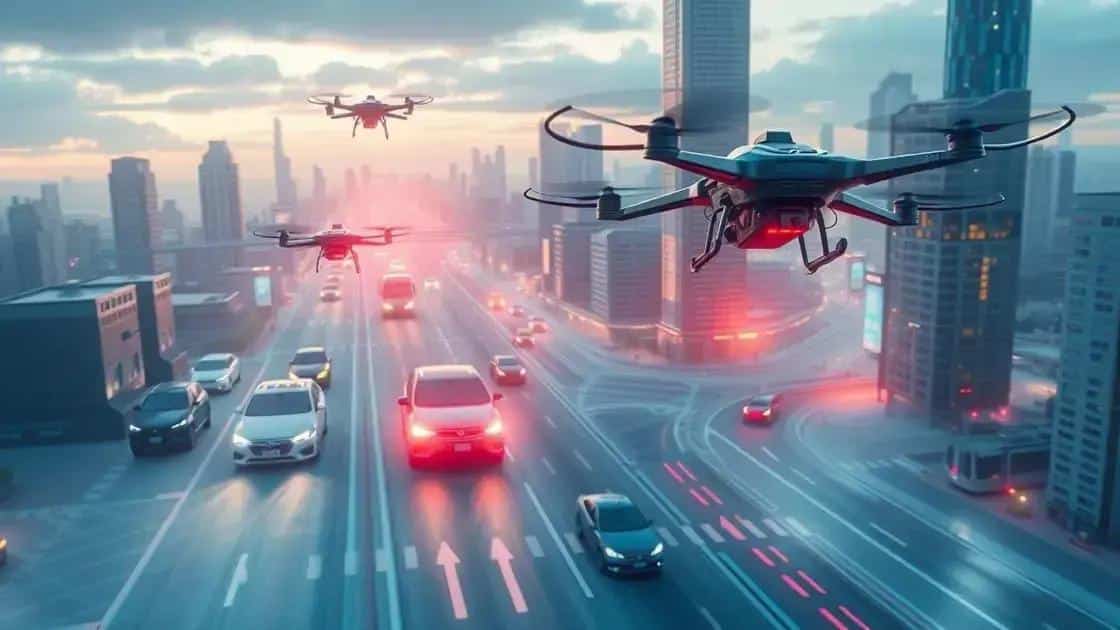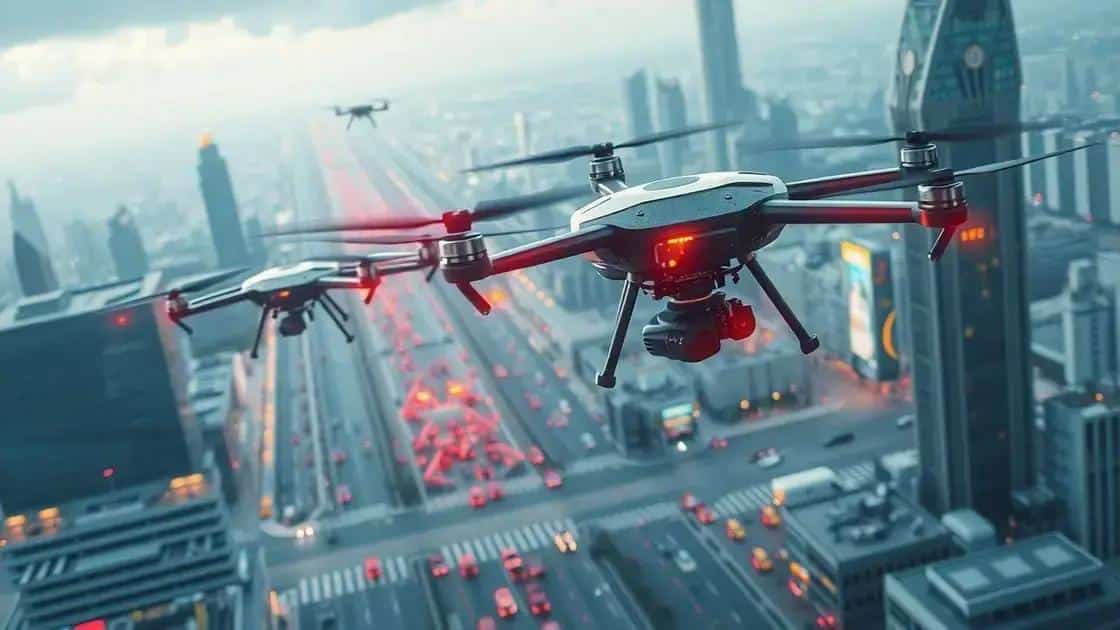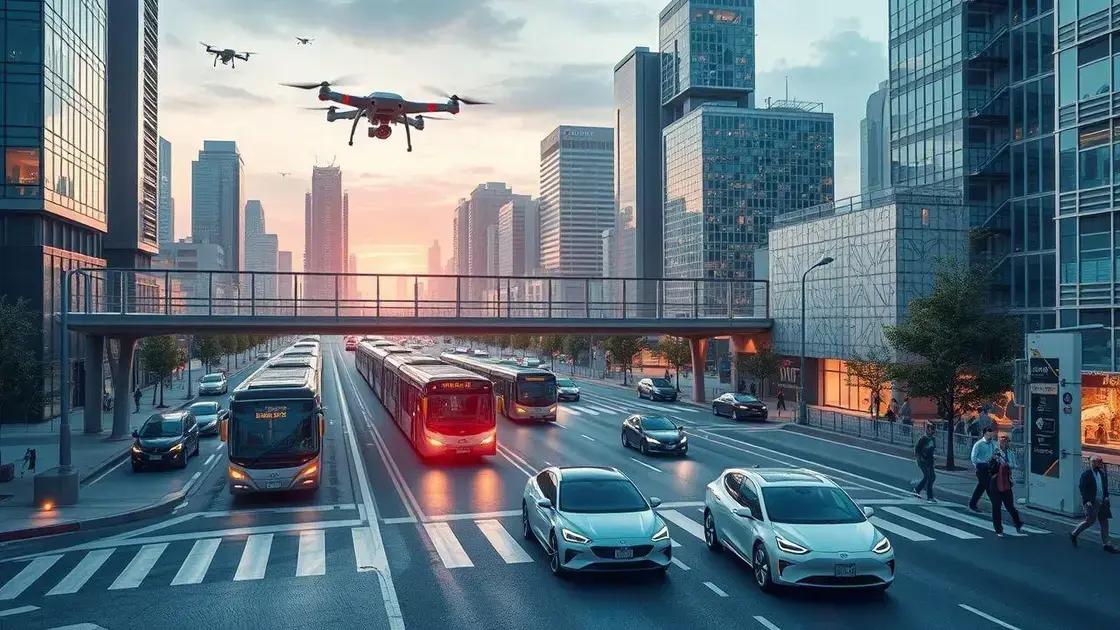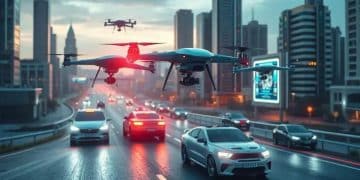Cars evolving: brain-assisted transportation and drone taxis

Combining cars and drones revolutionizes urban mobility by reducing traffic congestion, enhancing accessibility, and promoting environmentally friendly transportation options through innovative technologies.
Cars are evolving rapidly, thanks to innovative concepts like brain-assisted transportation and drone taxis. Have you ever imagined a future where your thoughts could help navigate through traffic? Let’s dive into these exciting developments.
What is brain-assisted transportation?
Brain-assisted transportation refers to innovative technologies that aim to enhance how we interact with vehicles by using brain-computer interfaces (BCIs). These advancements could completely change our driving experience, making it safer and more efficient.
Imagine a future where drivers can control their cars simply by thinking. This technology isn’t just a dream; it’s becoming a reality. Research and development in this field are progressing rapidly, and companies are working hard to make these systems viable.
How it works
Brain-assisted systems utilize sensors that read brain activity. When a person thinks about moving left or right, the system detects those signals and transmits them to the vehicle. This process involves a few key components:
- Sensors: Devices that pick up electrical signals from the brain.
- Software: Programs that interpret these signals and convert them into actions.
- Feedback Mechanisms: Features that provide responses to the user, ensuring smooth operation.
By integrating BCIs into vehicles, the potential for improved safety and accessibility grows. For example, individuals who cannot drive due to physical limitations could gain independence.
The benefits of brain-assisted transportation
Alongside increased accessibility, several benefits stand out:
- Enhanced Safety: Drivers can focus more on the road without distractions.
- Faster Reaction Times: Decisions can be made in real-time without delay.
- Total Focus: Users can engage their environment meaningfully and respond effectively.
Vehicles equipped with brain-assisted technology promise to not only keep us safer but also make navigating more enjoyable. As we embrace these innovations, it’s essential to understand their implications and explore how they will shape the future of transportation.
How drone taxis are revolutionizing travel

Drone taxis are changing the way we think about travel. These flying vehicles offer a new mode of transportation that is both innovative and efficient. Imagine soaring above traffic instead of sitting in it, reaching your destination faster and with less stress.
The technology behind drone taxis involves advanced robotics and drones designed for passenger transport. They are equipped with vertical take-off and landing capabilities, allowing them to operate in tight urban spaces. This technology is already being tested in several cities around the world.
Benefits of drone taxis
There are numerous advantages to using drone taxis:
- Reduced Travel Time: Drone taxis can bypass ground traffic, significantly cutting travel times.
- Lower Carbon Footprint: Many drone taxis are designed to be electric, offering cleaner and greener transportation options.
- Increased Accessibility: Drone taxis can provide service to areas that are difficult to reach by traditional vehicles.
The implementation of drone taxis promises to free up congested roads and offer easier access to transport. With ongoing advancements, many cities are exploring how they can integrate this technology into their existing transportation systems.
Challenges facing drone taxis
While the future looks bright, there are hurdles that must be addressed:
- Regulatory Issues: Governments need to create guidelines for operation and safety.
- Safety Concerns: Basing operations on reliable technology is essential to ensure passenger safety.
- Public Acceptance: Convincing the public to trust and use drone taxis is crucial.
By addressing these challenges, drone taxis could become a common sight in our skies, revolutionizing the very nature of how we travel.
The benefits of combining cars and drones
Combining cars and drones offers numerous benefits that could reshape the way we travel. This innovative approach can enhance convenience, efficiency, and safety in urban environments.
One major benefit is the ability to reduce congestion. With drones taking to the skies for short trips and traffic-heavy routes, cars can navigate more easily, leading to quicker commutes. This combination makes cities more navigable and helps reduce frustration.
Improved Accessibility
Using drones alongside cars has the potential to improve accessibility in multiple ways. For instance, drone deliveries can reach areas that are hard for cars to access, like remote locations. Drones can deliver medical supplies or food quickly to those in need, providing timely assistance.
- Rapid Response: Emergency services can utilize drones to deliver supplies faster.
- Logistical Efficiency: Businesses can streamline deliveries, cutting operational costs.
- Urban Planning: Reducing traffic congestion can lead to more pedestrian-friendly spaces.
The synergy between vehicles and drones also enhances safety. Drones can be equipped with sensors that monitor traffic conditions and relay information to cars. This real-time data can help prevent accidents and manage traffic effectively.
Environmental Impact
Many companies are developing electric drones that have a minimal environmental footprint. Combining these eco-friendly drones with cars can lead to a significant reduction in overall emissions. If widely adopted, this technology can revolutionize how we think about transportation sustainability.
- Lower Emissions: Electric drones contribute to cleaner air.
- Reduced Fossil Fuel Dependency: Fewer cars on the road lead to decreased fuel consumption.
- Innovative Transportation Systems: Cities can develop integrated transport networks.
The future of transportation lies in the innovative combination of cars and drones. By embracing these technologies, we enhance not only our travel experience but also the quality of life in urban areas.
Future implications for urban mobility

The future of urban mobility is set to transform dramatically with the integration of advanced technologies. As cities grow and populations increase, the need for efficient and sustainable transportation solutions becomes essential. Innovations like drone taxis and brain-assisted transportation will significantly shape how we navigate urban environments.
One major implication is the shift towards more sustainable options. Electric vehicles, including drones, contribute to reducing carbon footprints. This change encourages cities to promote environmentally friendly transportation methods, creating cleaner air and healthier communities.
Smart City Integration
As technology advances, cities will leverage smart systems to enhance urban mobility. Connected infrastructure will allow vehicles and drones to communicate with traffic systems, improving traffic flow and reducing congestion.
- Real-Time Data: Gathering information on traffic patterns helps optimize routes.
- Automated Traffic Management: Systems can adapt traffic signals in response to real-time vehicle movements.
- Public Transport Coordination: Integrating various modes of transport provides seamless travel experiences.
The rise of shared mobility options is another key trend. Car and bike-sharing services, combined with drone transportation, can reduce the number of vehicles on the road. This model caters to the needs of urban dwellers who may prefer flexibility over ownership. It also lowers traffic volumes, leading to less congestion.
Social Impact
New technology can influence social dynamics within cities. Enhanced mobility may lead to equal access to transportation options for all citizens, regardless of socioeconomic status. Deploying drones for deliveries in disadvantaged areas can improve accessibility to goods and services.
- Increased Connectivity: More people can access job opportunities and resources.
- Accessible Services: Transportation options can reach vulnerable communities.
- Community Building: Improved mobility fosters connections among residents and businesses.
The future of urban mobility hinges on embracing these technologies. By combining innovation with sustainability, cities can reshape how residents move and interact, fulfilling the demand for efficient and environmentally balanced urban experiences.
In conclusion, the integration of cars and drones is paving the way for a revolutionary change in urban mobility. These technologies promise not only to improve transportation efficiency but also to enhance environmental sustainability and accessibility for all. Embracing this future can lead to cities that are not only smarter but also more connected and livable.
FAQ – Frequently Asked Questions about the Future of Urban Mobility
What are drone taxis?
Drone taxis are flying vehicles designed to transport passengers quickly and efficiently above ground traffic, reducing travel time significantly.
How do cars and drones work together?
Cars and drones can complement each other by using drones for deliveries while cars handle personal transportation, alleviating road congestion.
What benefits do electric drones provide?
Electric drones contribute to lower emissions and provide sustainable transport options, helping to improve air quality in urban areas.
How will smart technology enhance urban mobility?
Smart technology will enable vehicles to communicate with traffic systems, optimizing routes and improving safety in urban transport.





